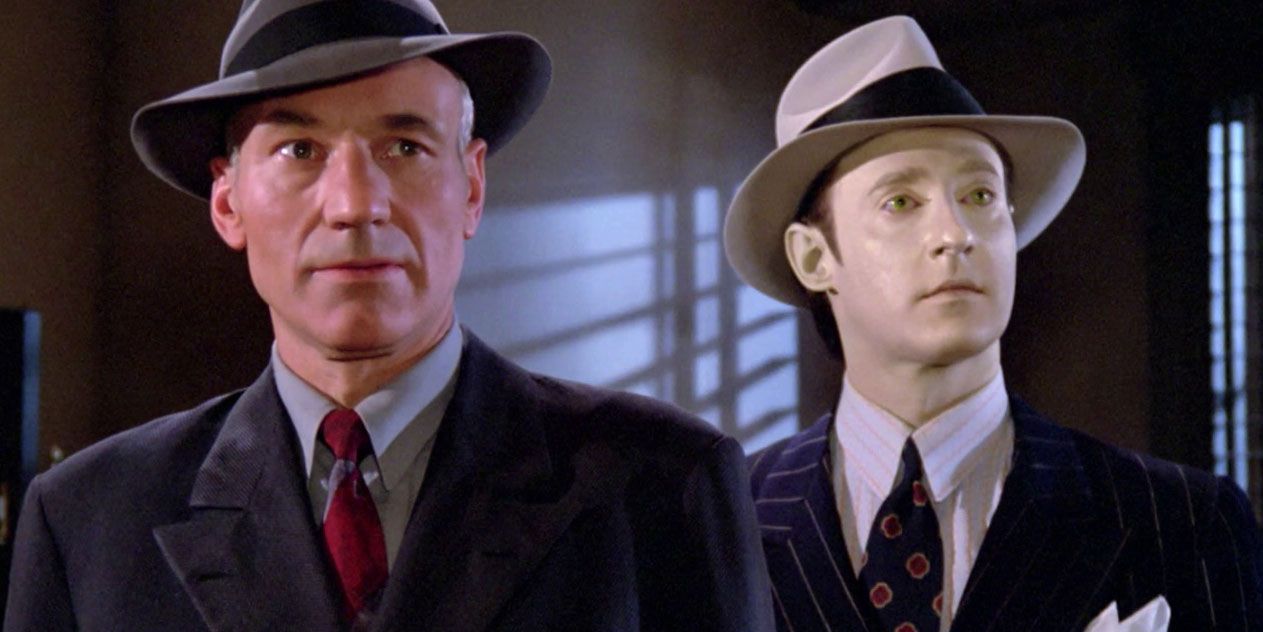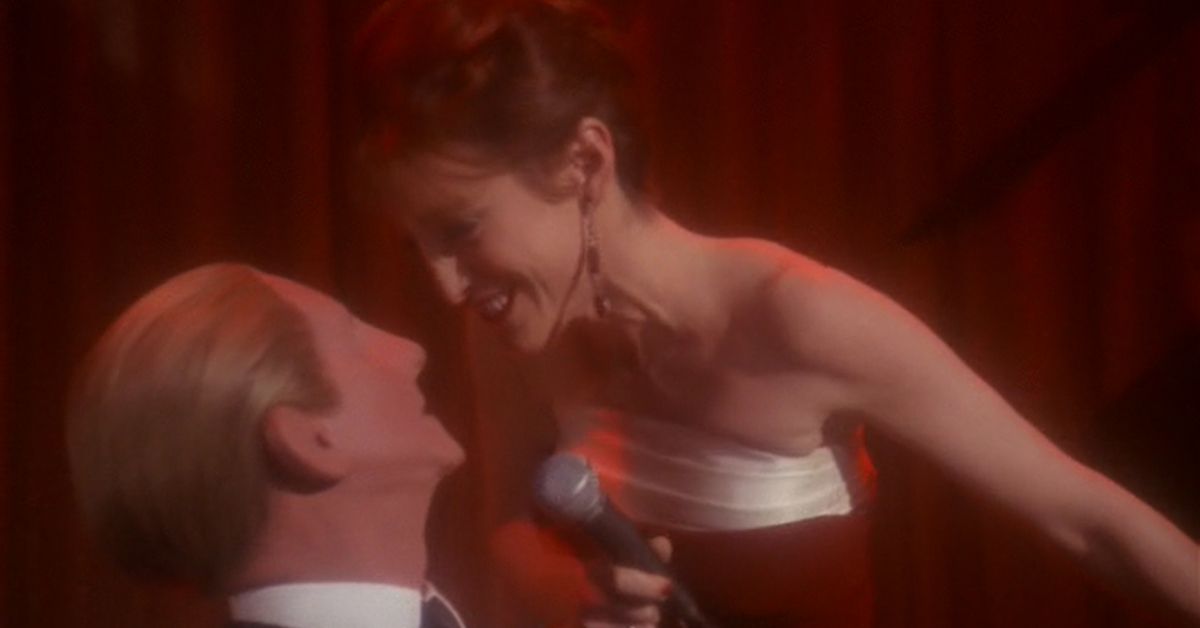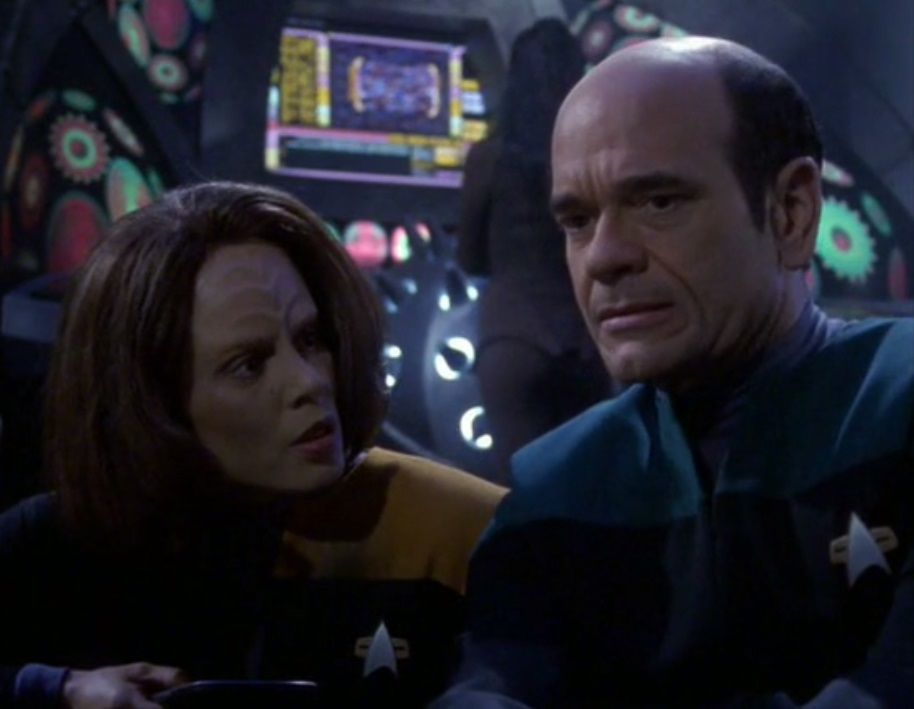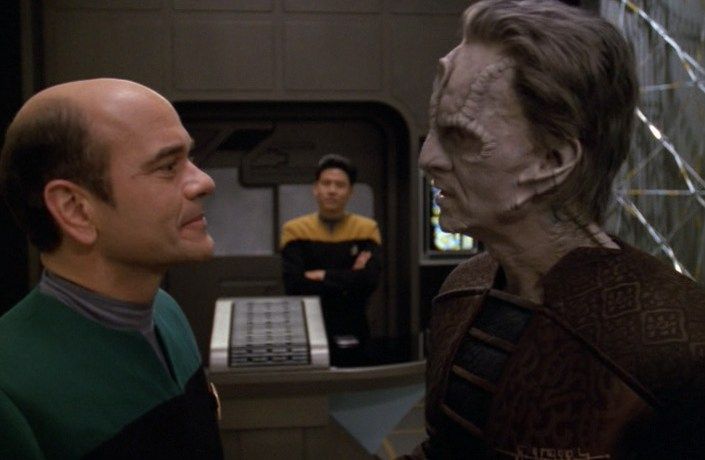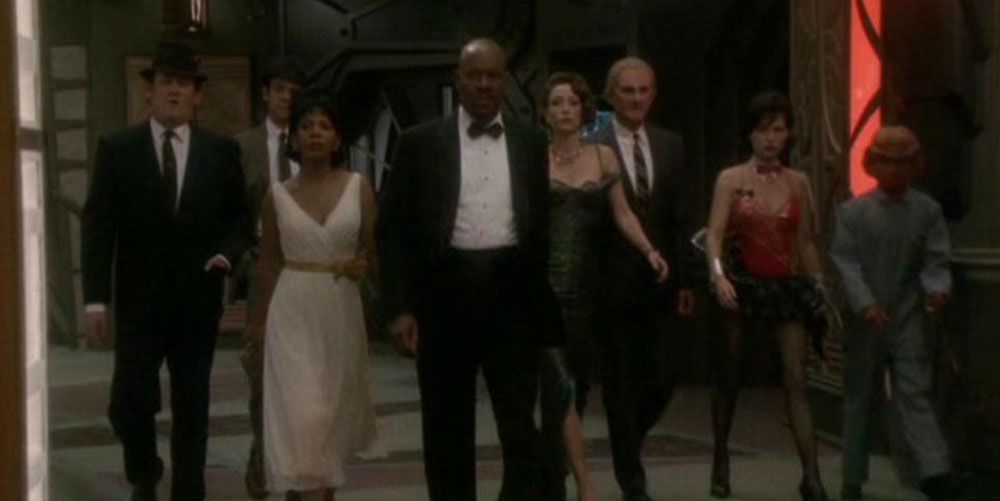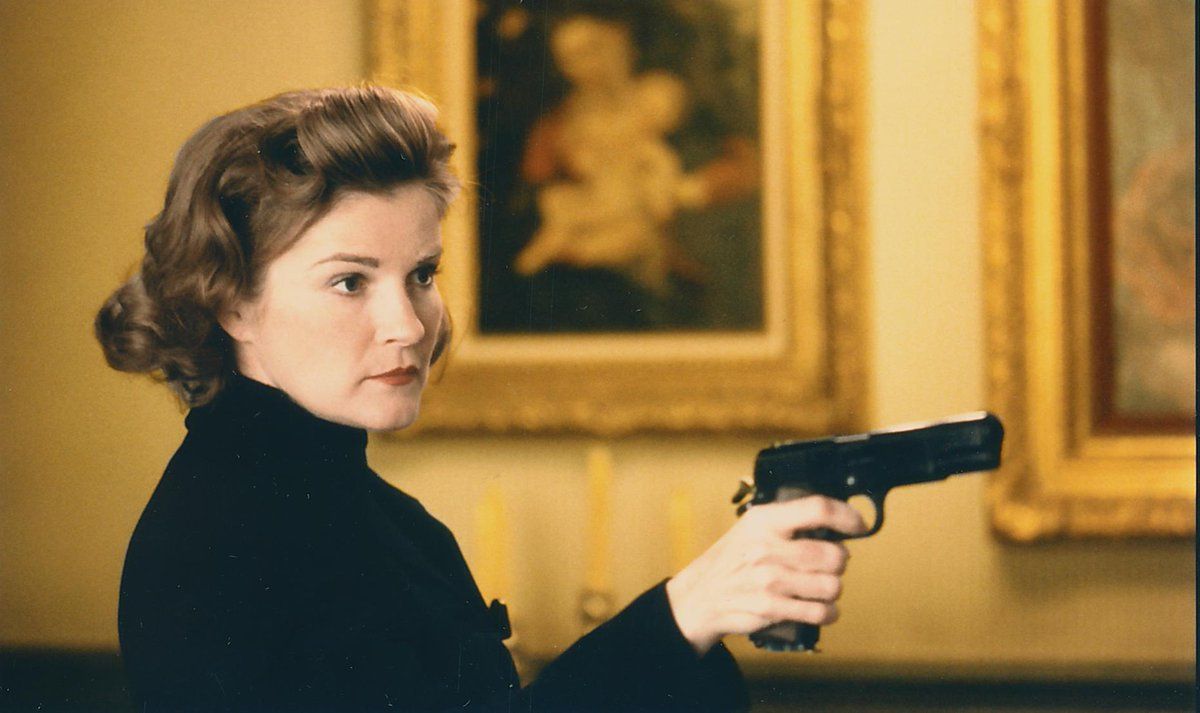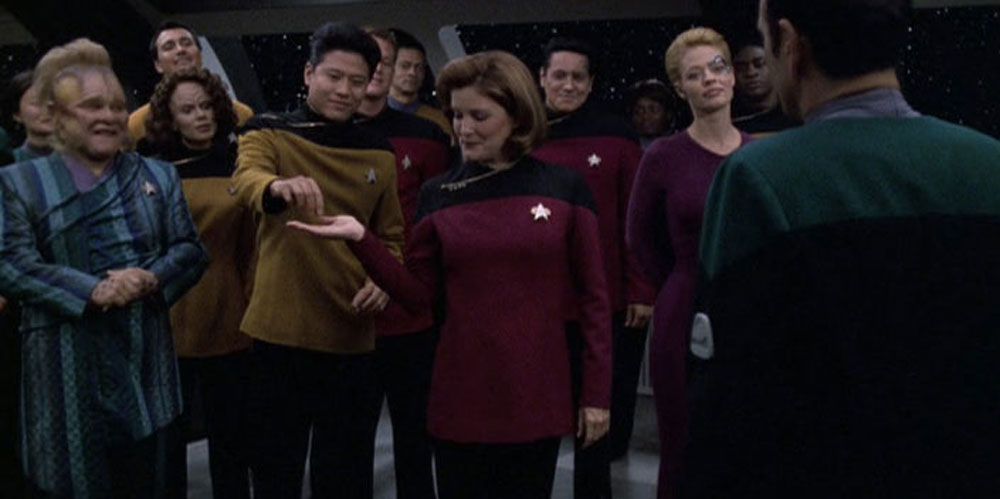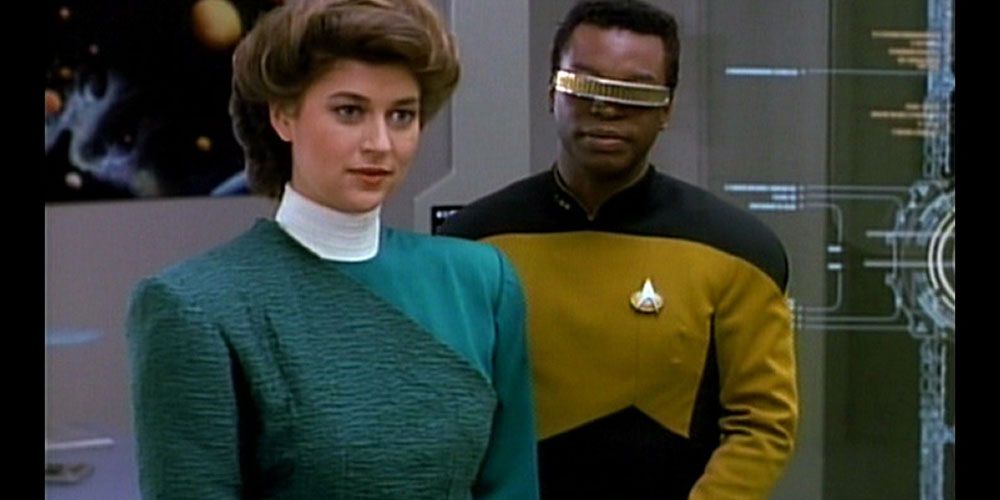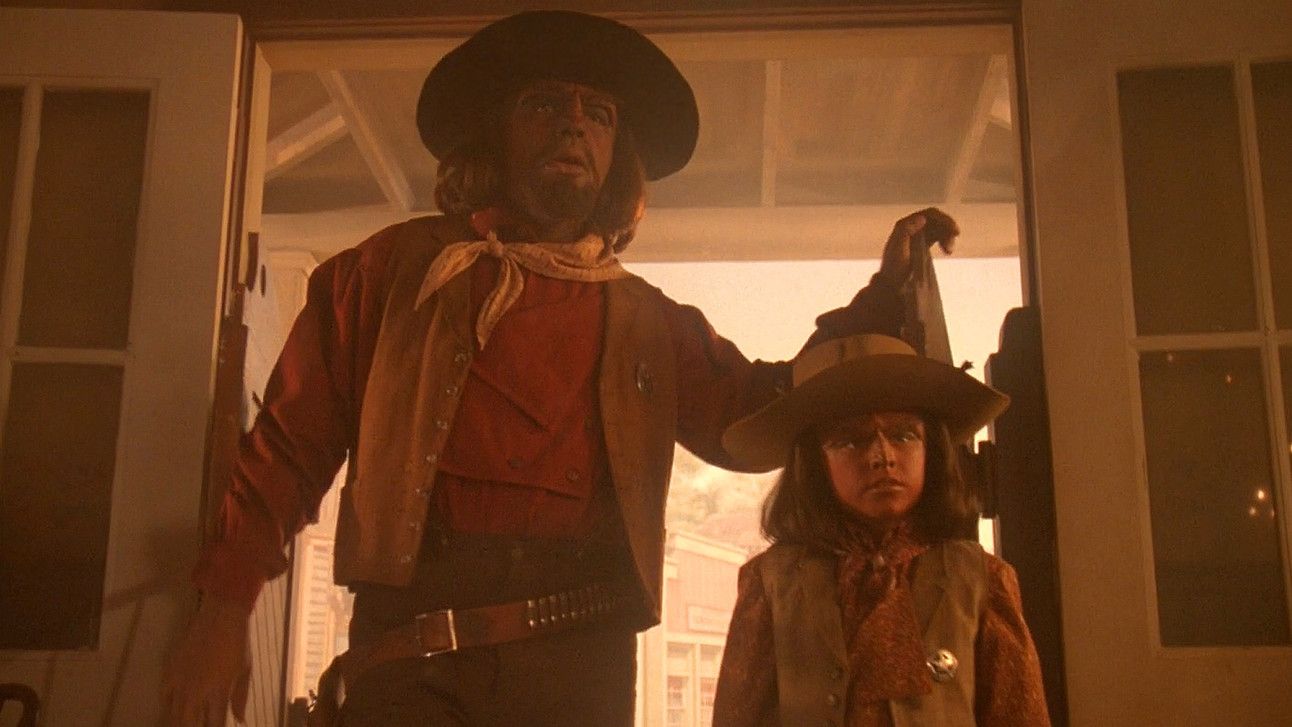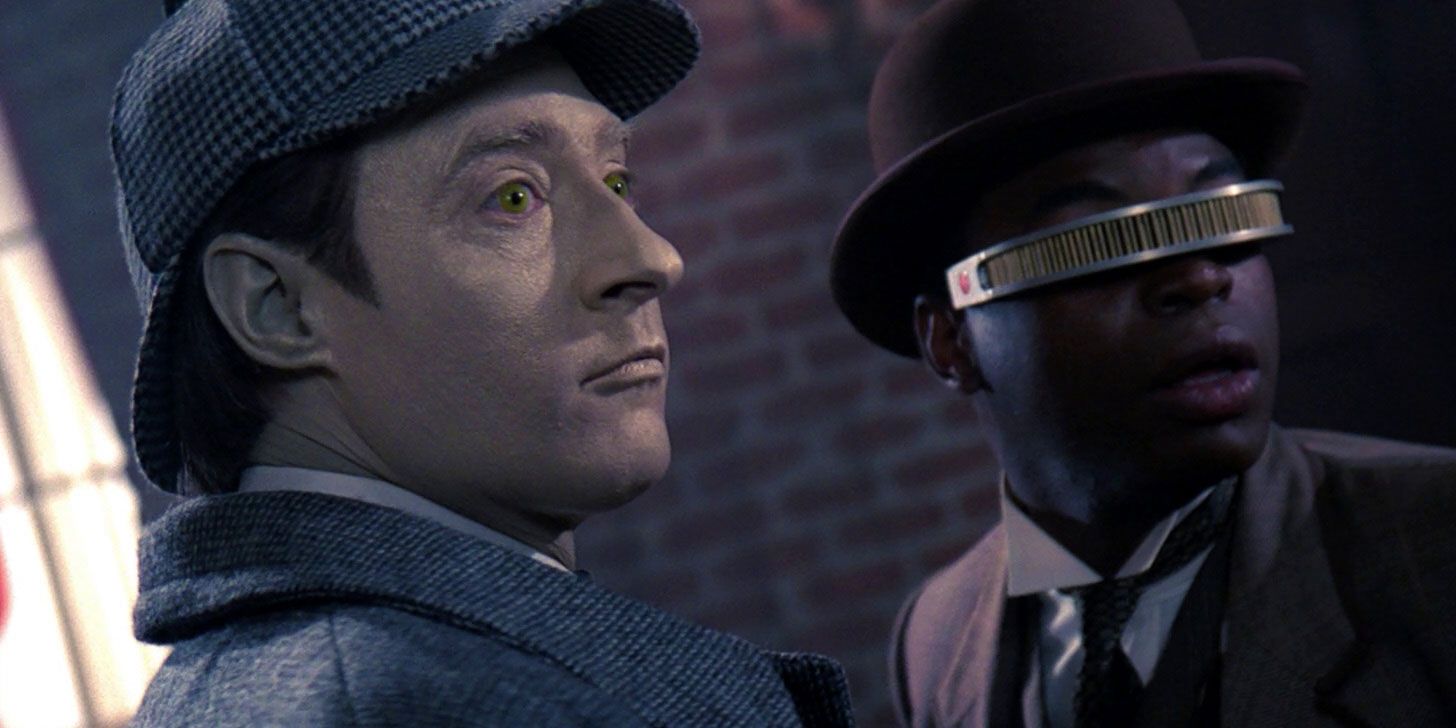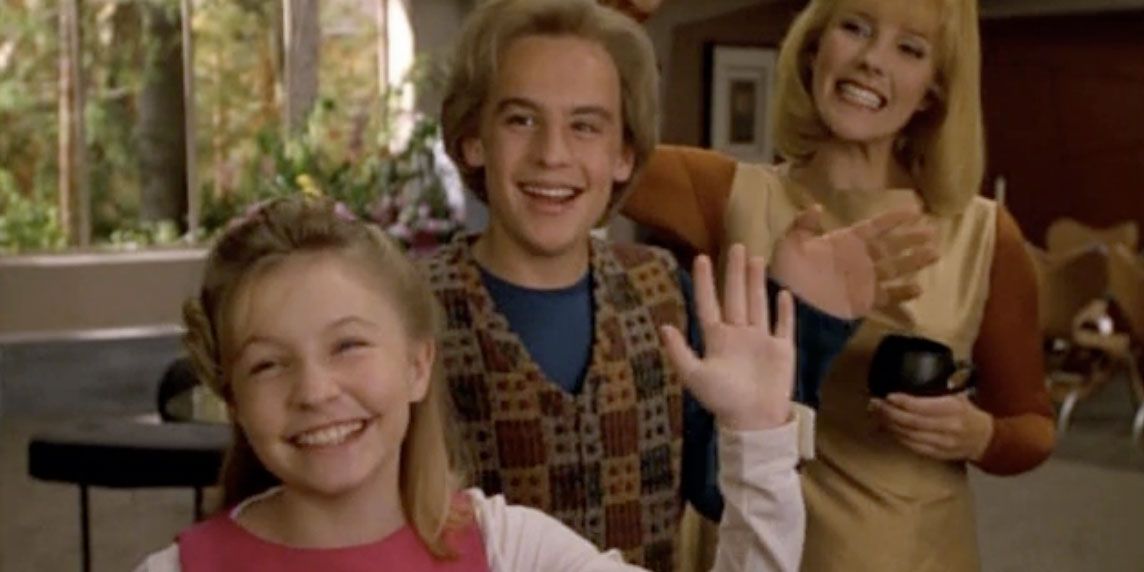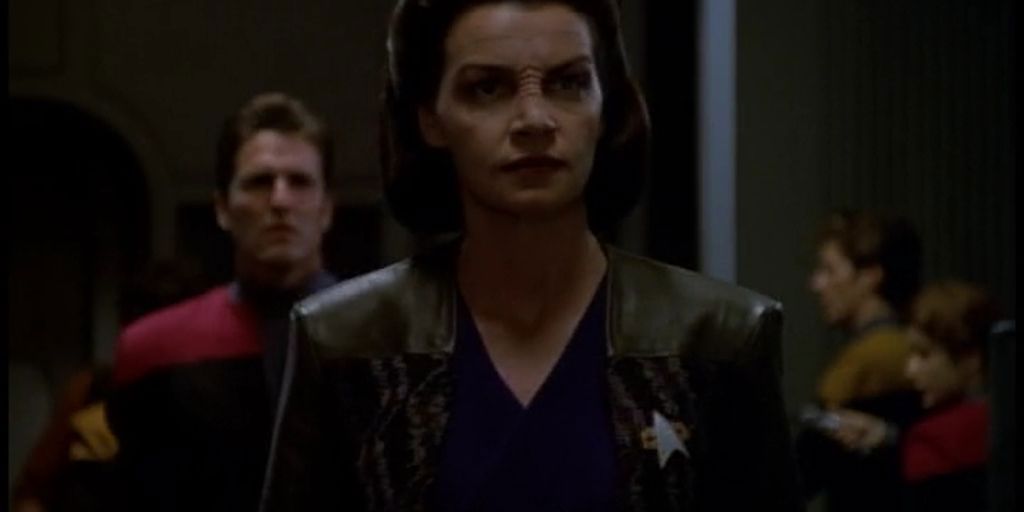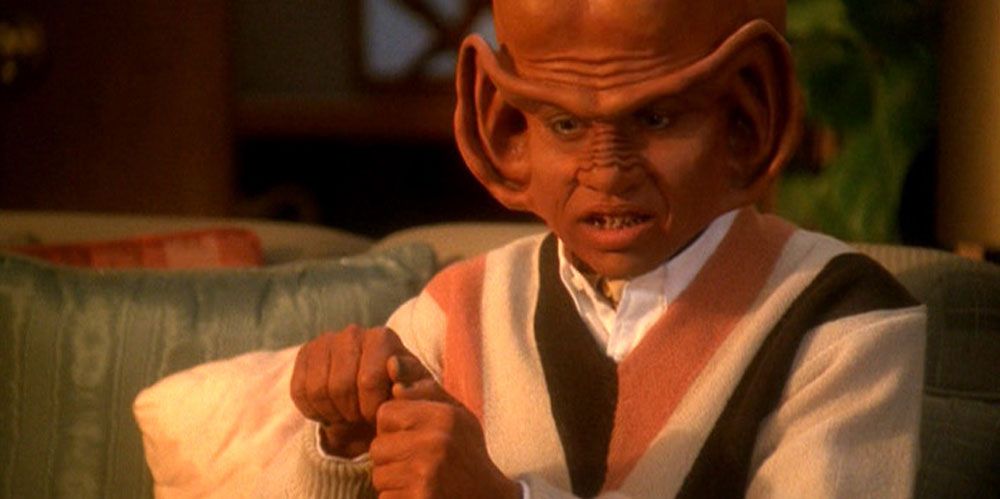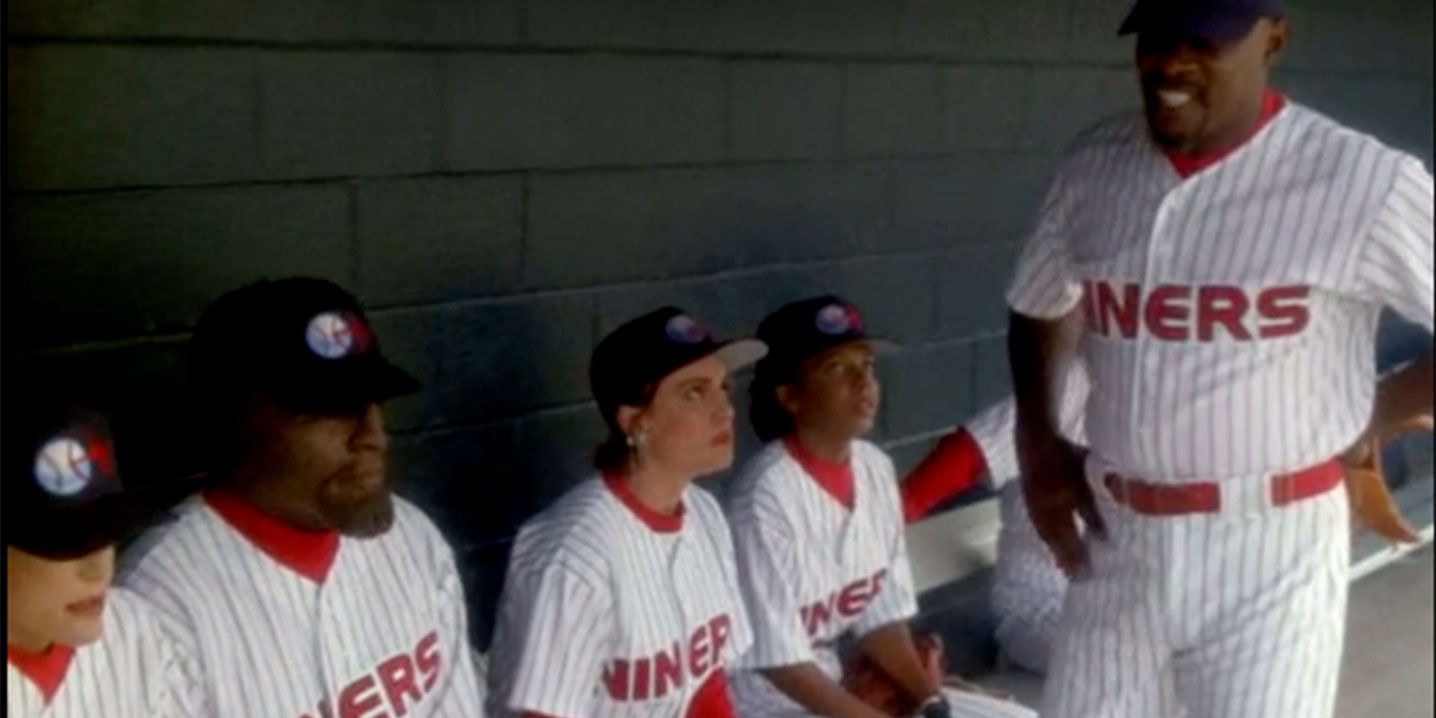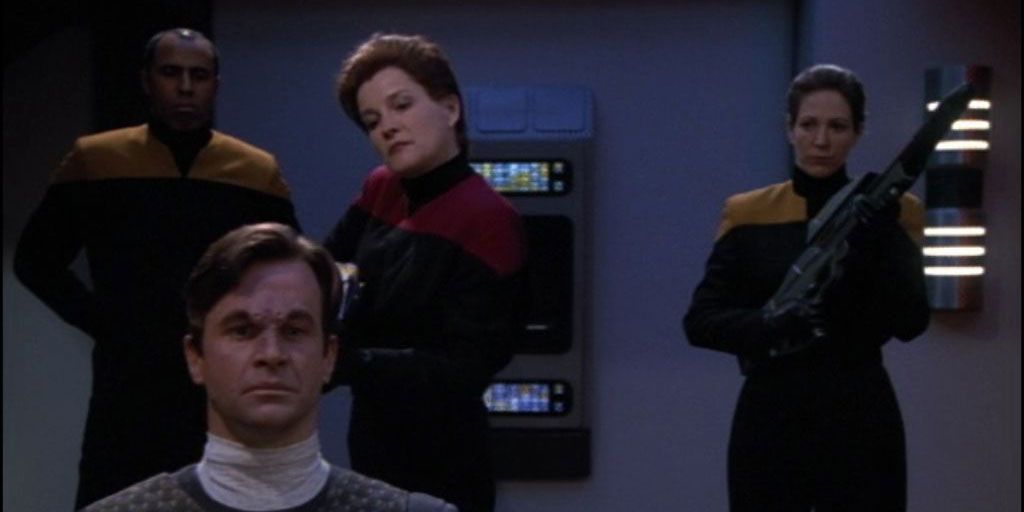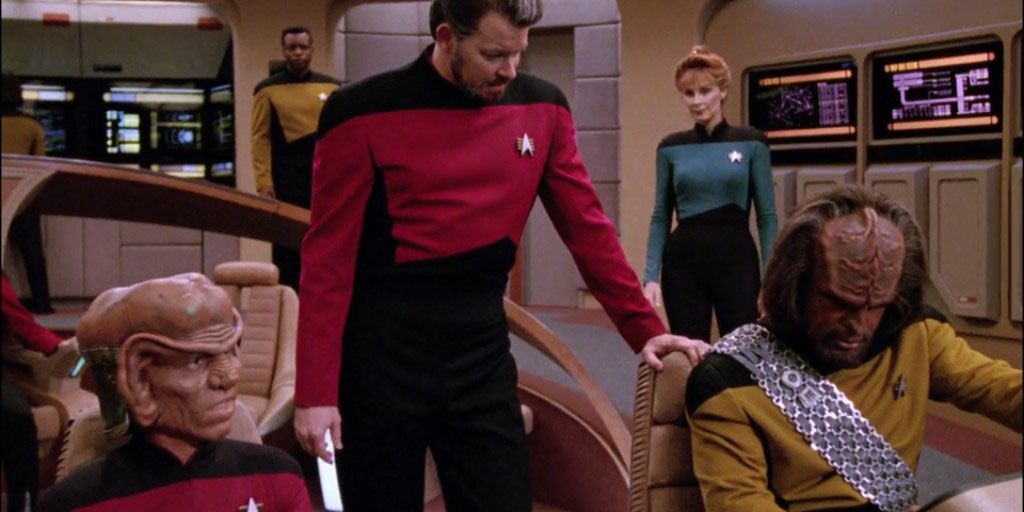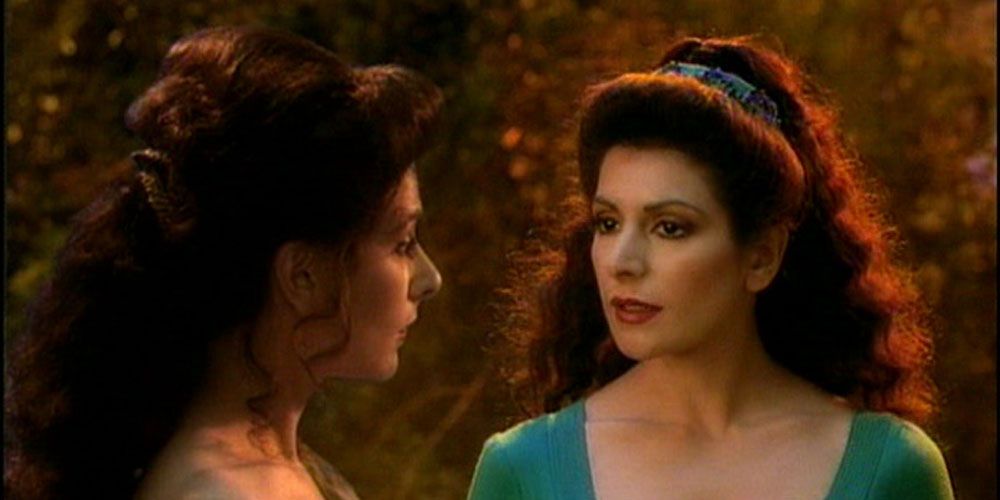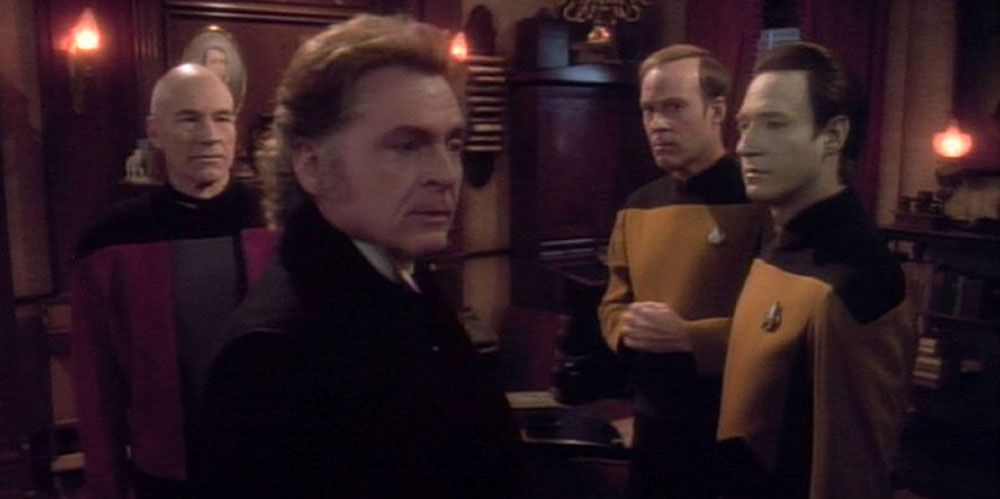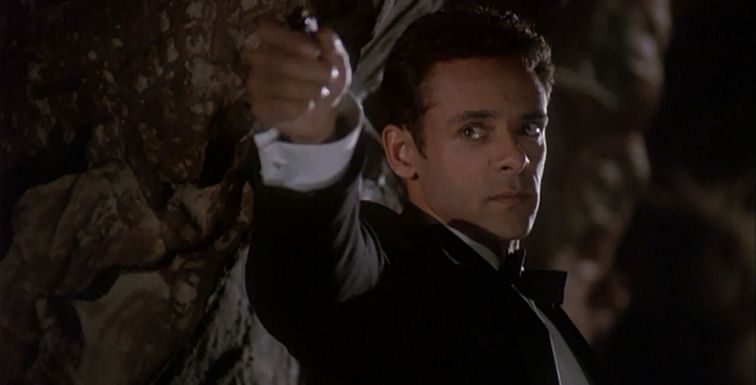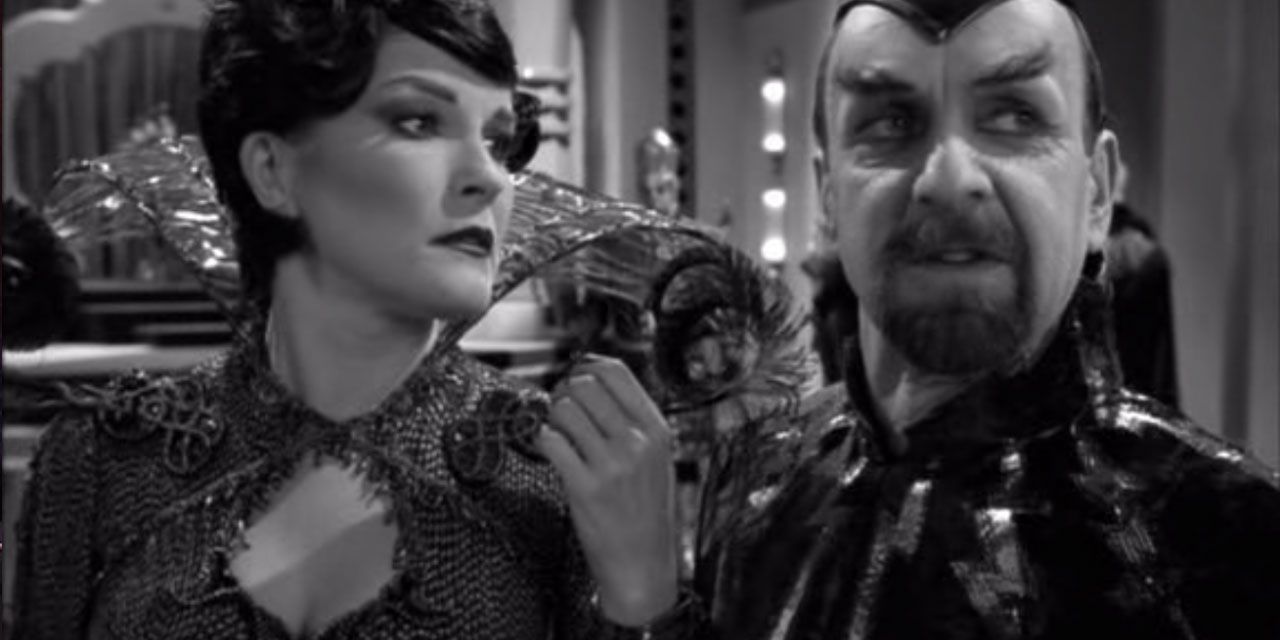When Star Trek: The Next Generation opened, it showed a dramatic upgrade in technology for the Federation. One of the biggest advancements was the holodeck. Inside a relatively small room, a fantastic three-dimensional recreation of any setting could be created. It could be anything from an alien world to various Earth periods, nailing it all down to the smells of the area. The figures inside could feel as real as anyone and it paved the way for major stories. TNG used it a lot while Deep Space Nine had Quark running holo-suites with some rather….intimate programs available for customers. It was home to the popular Vic Fontaine and other programs. Voyager also used it a lot which made sense as, so far from Earth, the crew needed something to indulge in for relaxation.
Of course, the holodeck has given a few duds in various episodes. “Fair Haven” and “Spirit Folk” are two of Voyager’s worst episodes. While it was historic for exploring the holodeck, TNG’s “11001001” has not aged well. But when it works, the holodeck can be a big deal. After all, it helped set up the EMH Doctor who became a major Voyager character and the fun of these unique adventures has led to some good storylines. Yes, the trope of “holodeck malfunction endangers the crew” could be a cliché but the writers kept finding ways to twist it around. In a few occasions, the holodeck could be used for an episode that’s nothing but pure wild fun. Here’s how 20 of the best holodeck-themed episodes rank in Star Trek lore to show how even in the far future, folks love to indulge in great distractions.
20 HIS WAY, DS9
The sixth season of DS9 introduced what would become a major recurring character in Vic Fontaine. Played by James Darren, Vic was the suave owner of a 1960s Las Vegas casino he also headlined as a singing star. The crew came to love hanging out there to the point of letting the program run full time. In this debut episode, Vic knows he’s a hologram but uses it to try and help others with their issues. This includes how he’s able to tell Odo has been in love with Kira for years and she is starting to feel the same way. He even gets Odo with a holographic singer who looks like Kira but Odo dismisses it as not being real.
In a flash of inspiration, Vic invites Kira to dinner at his club. He then tells Odo that an “improved” hologram of Kira will be his date. They have a nice dinner and even a dance before realizing how Vic set them up. At first, they’re both upset but it does get them to finally face up to their feelings. This leads to the classic scene of them arguing about another date, each snapping at the other on how to act before finally kissing in front of the entire Promenade. It was a key moment for both characters thanks to a holographic match-maker.
19 FLESH AND BLOOD, VOY
At the conclusion of “The Killing Game,” the Voyager crew made peace with the Hirogens by giving them holographic technology. Janeway figured it was better for the Hirogens to hunt holograms than actual beings. In this two-part tale, the ship discovers a disabled Hirogen vessel. It seemed the Hirogens programmed the holograms to be as deadly as possible in order to be challenging prey. This blew up in their faces as the holograms have developed true intelligence and are able to turn the tables on the Hirogens. The Doctor is soon captured by these holograms, led by Iden. The Doctor is horrified to realize these holograms actually feel pain and even death and keep being brought back so it’s no wonder they’re lashing out at their creators.
Even as the Voyager crew aid the Hirogens, the Doctor starts to think the holograms have an actual point and aids them. But the Doctor becomes troubled as to how the holograms worship him so openly and how Iden is ready to wipe out the Hirogens to gain his freedom. It’s an intriguing tale tackling how holograms can become individuals, warts and all and even the Doctor is swayed by that. As Janeway points out at the end, the Doctor making mistakes and overcome by his emotions just proves he’s becoming more like a real human.
18 NOTHING HUMAN, VOY
This episode opens in a light way as Chakotay and Harry enjoy the rest of the crew forced to listen to one of the Doctor’s lectures. The humor ends when Torres is attacked by a deadly parasite. Even the Doctor is having trouble figuring it out so goes over records to find a biologist named Crell Moset whose research can help. He creates a hologram of the scientist who bonds with the Doctor as they try to find a cure. However, a Bajoran crewmember reveals that Moset was a Cardassian war criminal who was responsible for horrific experimentation on thousands of innocent people.
Thus, an ethical debate rages on whether a hologram should be held responsible for the crimes committed by the real person. There’s also how Tom insists on ignoring it to save B’Elanna but Torres herself says she’d rather die than owe Moset her life. Moset doesn’t help his case by stating that those experiments were simply science. While the episode has Torres surviving, the Doctor must make the final judgement on Moset to show how a holographic Cardassian can still be deadly.
17 BADA BING BADA BANG, DS9
Knowing they were about to embark on the massive nine-episode storyline that would conclude the series, the DS9 writers decided to do one last funny one-off episode. Bashir and O’Brien are visiting their beloved Vic Fontaine program when Vic rocks them by revealing he’s been forced to sell his casino to some mobsters who have turned it into a cabaret. O’Brien figures they can just rewrite the story only to find the program won’t let them. The crew realize that to save Vic’s place, they need to act out a 1960s type plot within the storyline. At first, Sisko can’t believe they’re treating this so seriously but realizes the crew thinks of Vic as a friend and agrees to help.
Thus, we have a Star Trek version of Ocean’s 11 as the crew dress up in full ‘60s regalia to pull off a complex heist. The sight of Dax as a cigarette girl and Kira dressed up to flirt is great. Even Sisko gets into it as, to the amazement of everyone, he actually starts singing as a distraction for the scheme. The plot itself is a brilliant scam that uses the holodeck technology to pull off an ace bait-and-switch. It was one final gasp of humor before DS9 got darker but it was a great romp.
16 THE KILLING GAME, VOY
This two-part episode has its detractors but still intriguing for the set-up. Once again, the Voyager crew tangle with the Hirogens, a race who are obsessed with hunting other species. Having taken over the ship, the Hirogen leader comes with a unique idea. He has the crew mind-wiped and then put into constant holodeck scenarios based on Earth wars that the Hirogens can use for hunting. The latest is a World War II setting where Janeway is a spy/club owner, Seven a spy/singer, Torres a French girl and the rest of the gang Allied soldiers.
Putting the crew into a WWII setting makes for some intriguing set-ups with Janeway and Seven showing off a bit more. There’s the tension of the Doctor and Harry figuring out a way to free the crew from this situation. Even the Hirogens come off nicely, their commander seeing the Voyager crew as “worthy prey” and the touch of how they actually despise having to act like Nazis. The ending paves the way for the episode “Flesh and Blood” while showing the darker sides of the holodeck.
15 TINKER, TENOR, DOCTOR, SPY, DS9
The opening should make it clear this is a holodeck episode. First, there’s how everyone in the mess hall is utterly enthralled by the Doctor’s beautiful singing. Tuvok breaks out into tears and only the Doctor can calm him down via song. It seems the Doctor has taken to “daydreaming” which means he’s created a link to the holodeck to live out fantasies of being a hero. This includes a wild scenario where Janeway is taken down and the Doctor activates the “Emergency Command Program” to take command. He also imagines Janeway and Seven fighting for his attentions.
Naturally, the Doctor is humiliated when the crew stumble onto his dreams. What he doesn’t realize is that an alien has been tapping into the holodeck but mistaken the dreams for reality to order his race to attack Voyager. The guy realizes the truth and this could be a disaster if his people attack. Convinced of the threat, the crew decide to use the misconception and have the Doctor pose as the Captain to trick the aliens. It’s soon clear the Doctor is more the hero in his fantasies then in reality which nearly ruins things. While it’s funny watching the Doctor playing hero, the episode is also a good step to how the character was accepted as a real individual by the crew.
14 BOOBY TRAP, TNG
This season 3 episode has the Enterprise arriving in an area of space to find a ship from a war that wiped out two races centuries before. Picard is excited to visit it but his joy fades when the Enterprise’s engines shut down. Somehow, they’ve triggered the same “booby trap” that ruined that other vessel and have to figure a way out of it. Geordi is attempting to figure out the engines and goes over the data of Leah Brahams (Julie Warner), the scientist who created them. To aid him, Geordi has the holodeck craft a version of Leah to give advice.
At first cold, the holo-Leah has some personality put into her and she and Geordi get along. They even share a kiss with Geordi realizing he has to end it fast as Leah does give him the solution to save the day. Warner was quite good in the role and a nice chemistry with Geordi. This paid off in “Galaxy’s Child” where Geordi met the real Leah, who was far more arrogant and stand-offish and was not happy seeing this holographic version of her. Even with holographic ladies, Geordi can’t catch a break.
13 A FISTFUL OF DATAS, TNG
Some fans argue about this episode but it does provide a great showcase for Brent Spiner. Worf is trying to find some bonding time with son Alexander and suggests the holodeck. Rather than engaging in classic Klingon battles, Alexander talks his father into an Old West simulation and Troi joins them. Worf is barely inside when the inevitable malfunction occurs thanks to how Data is being plugged into a ship interface. As a result, several of the key holodeck characters all now look like Data from the wicked gunslinger to a bandit to even a saloon dancer.
The sight of Worf in cowboy gear is good but better are the various Datas. Seeing the android talk in a variety of accents from Western to Mexican is fun and Spiner clearly is enjoying himself. There is some drama as Worf knows Data has better reflexes, making a showdown with him very dangerous. But we get some good bonding between Worf and Alexander and even Troi seems to be having fun in cowboy clothing. The ending is nicely done to make this a fun showcase for holodeck zaniness.
12 ELEMENTARY, DEAR DATA, TNG
Data as Sherlock Holmes is a rather brilliant idea. Geordi is looking forward to being with Data as his Watson but is annoyed as Data’s computer mind means he can instantly figure out a mystery fast thanks to having read all the Holmes stories. Inspired by Doctor Pulaski, Geordi instructs the computer to craft a foe even Data would have a tough time against. Of course, it’s Professor Moriarty (Daniel Davis) who leads the two through a fun mystery. But things take a turn when Moriarty asks an abducted Pulaski just what the Enterprise is.
The computer decided to interpret “an equal foe to Data” to mean making this Moriarty as smart as possible…so smart that he understands he’s just a hologram on a ship. Davis is fantastic in the role as a cultured villain fascinated by this mystery. It threatens the actual ship until Data is able to talk Moriarty into accepting his place in the holo-matrix. This episode laid the groundwork for how holograms could be actual beings in their own way and also set up a fantastic sequel a few seasons later.
11 THE BIG GOODBYE, TNG
This was one of the first major holodeck episodes and (amazingly) is the only TNG episode to win a Peabody Award. To the surprise of the crew, the cultured Captain Picard loves to play Dixon Hill, a rough and tumble 1940s private eye. Crusher is with a historian who join Picard in an adventure, seeing it as just a good time. The historian gets a bit too much into it, goading some of the holographic gangsters, confident as this isn’t real. He’s thus shocked when one of them shoots him. It turns out a solar accident has caused the first (but far from the last) holodeck malfunction to seal the crew inside and disengage the safety protocols.
Things get more serious with Picard breaking character to tell the characters they’re just holograms. The main gangster doesn’t believe it but when the holodeck is fixed, he and his colleague attempt to leave, only to vanish into nothing. There is a dramatic bit as one of Dixon’s allies asks Picard what happens to him when the program is off and Picard realizes the guy thinks of himself as a real person. This was the first episode to explore the holodeck as an actual setting and one of the bright spots to the otherwise rough first season of TNG.
10 REAL LIFE, VOY
The Doctor’s quest to understand humanity was at the core of his character on Voyager. In “Real Life,” the Doctor decides to embark on a family existence by creating a holographic wife, son and daughter. Kes and Torres show up for dinner where they realize the family are straight out of a 1950s sitcom. Torres tells the Doctor they’re just “too perfect” and totally unlike any actual family out there. He decides to program in some “realistic” character touches. Soon, he has a wife too busy with her own career and two teenagers acting up majorly.
The Doctor does his best to handle it but things just amp up with one kid hospitalized and facing “death.” At the same time, Paris is injured for real and the Doctor thinks this “family drama” will keep him from doing his job. Paris informs him how real life means taking the good with the bad and thus the Doctor has to handle this. It’s a more dramatic episode then it seems to show how even a holographic family can pack a punch.
9 WORST CASE SCENARIO, VOY
The opening act of this Voyager episode is gripping. Torres is approached by Chakotay who tells him that “things are going to change” and wants to know what side she’s on. Chakotay takes advantage of Janeway being off-ship to pull off a mutiny, arguing that it’s the best way to get to Earth. The fact that Seska is not only alive but looks Bajoran should be a tip-off this is fake. As it happens, Torres stumbled onto a holodeck program of a mutiny. Before long, it becomes a popular game for the crew who are thrown to find it has no ending. It turns out the whole thing was created by Tuvok as a training exercise when Voyager first began its trip.
Pressured to end the story, Tuvok and Paris head to the holodeck which then seals behind them. The ever-conniving Seska found the program and her avatar announces that she’s going to finish it her way. All the safeties are off so Tuvok and Paris find themselves in serious danger as Seska and her holographic crew hunt them down. The rest of the crew have to find a way to alter the program’s story to let the two survive. As Paris openly states, even a holographic Seska is a major pain for the Voyager crew to handle.
8 IT’S ONLY A PAPER MOON, DS9
DS9 went to darker places than other Trek series so it’s no surprise one episode openly tackles the issues of PTSD. Having lost a leg in battle in an earlier episode, Nog returns to the station, naturally quiet and withdrawn. The crew understand and are willing to help. Nog turns to Vic Fontaine’s program for some release and hangs out there. He then shocks everyone by moving into one of the hotels of the program. Indulging in fantasy is one thing but literally living there shows Nog has some problems.
Even Vic recognizes it, openly telling Nog he can’t just live in a 1960s world for the rest of his life. Nog just gets into it more, even becoming Vic’s “accountant.” When Nog won’t let go, Vic decides to give him a wakeup call by shutting his own program down. He makes Nog realize that sinking into fantasy can just hold him back from actually living his life. It’s a daring take on a serious issue that DS9 manages to pull off nicely.
7 TAKE ME OUT TO THE HOLOSUITE, DS9
The final season of DS9 is packed with grim stuff thanks to the war with the Dominion. So it’s notable it also has one of the funniest episodes of the series. Sisko meets with Solok, a former classmate at Starfleet Academy. The two have long been rivals thanks to Solok’s belief Vulcans are superior to humans at anything. He decides to prove it by challenging Sisko to the exclusively Earth game of baseball. Sisko agrees, confident his crew can handle any challenge. It’s not until they head to the baseball holosuite that Sisko realizes a tiny flaw in his plan: he’s the only one who has the slightest idea how to play the game.
Watching Sisko, a man who has handled Cardassians, Jem’Hadar and other enemies with cool resolve, completely lose it over baseball is hysterical. The crew are just totally inept at everything from ball play to banter (Worf: “Death to our enemies!”) to drive him crazier. There’s also Odo taking his role as umpire a bit too seriously. The game is a riot just for the sight of the crew in uniform and the fact they’re losing for most of it. However, it ends up bonding them together to show how a simple sports game can help even the darkest of times.
6 LIVING WITNESS, VOY
Technically, it’s not the regular holodeck but it does count. The opening act is jarring as we see the Voyager crew who are basically a pack of murderous thugs with an android Doctor and a Seven who’s still a full Borg. The crew are allied with the Vaskans to steal materials and brutally wipe out an attacking wave of Kyrian forces. It turns out this is all the “holographic records” of a Kyrian museum showing what happened 700 years earlier. Historian Quarren has grown up accepting Voyager as monsters who nearly destroyed his race. Going over some old evidence, he accidentally awakens the holographic Doctor.
The Doctor is appalled to see the “records” showing the crew as villains (“somewhere across the galaxy, Captain Janeway is spinning in her grave”). He then shows what really happened in that it was the Kyrians who were the bad guys attacking the noble Vaskans and their “great martyr” was a total thug. This causes massive riots across the planet but Quarren and the Doctor are determined the truth is more important. The ending reveals this is all another holographic record but one showing two men fighting to help their world achieve a new peace. The opening is good but the rest of the episode has the holodeck programs used to highlight the old “history is written by the winners” mantra.
5 FUTURE IMPERFECT, TNG
This often ends up on lists of the best TNG episodes. On his birthday, Riker is beaming down for a mission only to wake up in sickbay with his hair grey and being called Captain. Crusher tells Riker he’s dealing with the effects of an illness that’s caused him to lose memory of the last 17 years. Riker is now captain of the Enterprise with Data his first officer; Geordi can see without his VISOR; a Ferengi is at the helm; Picard is an admiral; and Riker has an 11 year old son. Riker is told he has to handle a peace meeting with old Romulan foe Tomalok.
Various odd bits make Riker suspicious of all this. The kicker is when he’s shown videos of his supposedly late wife…and realizes it was a woman from a holodeck program. This leads him to expose how this is all a Romulan plot to trick Riker into giving up secret information. His “son” is a real orphan as they go on the run. But there’s one more twist to come that changes the game majorly. Fans love the look at this supposed future and a good spotlight for Riker while showing the nice twists a holodeck is capable of.
4 HOLLOW PURSUITS, TNG
When we first see Reginald Barclay (Dwight Schultz), he’s a tough guy in Ten Forward who ends up punching out Riker in a fight. It turns out to be a holodeck program as Barclay is a truly brilliant engineer but a social wreck and can only live out his dreams in holograms. LaForge is concerned so he, Riker and Troi check out Barclay on the holodeck. There, they find his programs which are always intended to make himself the hero of things. That includes one of the main crew as the Three Musketeers who hail Barclay as a hero.
A hilarious bit has Troi saying this is no big deal…then sees how Barclay has a version of her that’s obviously in love with him (her “muzzle it” to “herself” is priceless). LaForge notes how Barclay’s addiction to the holodeck is damaging and holding him back from being himself. As it happens, an emergency pushes Barclay to finally stand up and assert himself to save the day. He bids farewell to the holodeck (except for one special program) to try and live his life. It’s a great parody of some Trek fans but also introduced the popular Barclay character to make it more important.
3 SHIP IN A BOTTLE, TNG
It took a while but someone in the TNG writer’s room finally remembered “Elementary, Dear Data” and decided it was time for a follow-up. Going over old holodeck programs, Barclay is thrown to revive Professor Moriarty who knows what he really is. Moriarty then shocks everyone by actually being able to leave the holodeck, using the idea that because he believes himself to be a real person, he truly is. As they try to figure things out, Moriarty wants them to also allow his love, Countess Regina Bartholomew, to become real.
When the crew refuse, Moriarty takes control of the Enterprise and threatens the ship. Of course, there comes the twist: Data realizes that Moriarty never left the holodeck. Rather he, Picard and Barclay are stuck in a massive program as part of Moriarty’s plan. As before, Daniel Davis is magnificent as a Moriarty you can root for and obviously wanting to be a person of his own. The ending throws in one more twist to set it right and caps off a fine sequel that shows how tricky the holodeck can truly be.
2 OUR MAN BASHIR, DS9
Airing right around the time of the release of Goldeneye, it’s pretty obvious what the inspiration for this tale is. Garak drops in on the holodeck to find Bashir engaging in a program where he’s a suave James Bond-style 1960s secret agent. When Kira (with an outrageous Russian accent) pops in, Bashir assumes she’s joining the fun. In reality, an accident has caused Kira, Sisko, Dax, Worf and O’Brien to somehow be integrated into the characters of the program. As leaving the holodeck might kill them for real, Bashir and Garak have to play out the program
It’s obvious the actors are enjoying this spy thriller. The biggest is Avery Brooks who goes wonderfully over the top as the Bond-like super-villain with the typical “destroy the world” plot. There’s also the comedy in how Garak, an actual experienced spy, is thrown at this romantic tale (“Kiss the girl, get the key, they never taught that in the Obsidian Order”). The ending is a bit more dramatic with Bashir making a surprise move to save the day. Sadly, we never lived up to Bashir’s promise that “Agent Bashir will return” but this just makes this episode stand out more for showing Bashir’s more dashing side (and how Alexander Siddig might have made a good Bond).
1 BRIDE OF CHAOTICA!, VOY
Hands down the funniest episode of Voyager, this is nothing but a pure romp. For some time, Tom has been obsessed with “Captain Proton,” a holodeck program playing like a 1930s sci-fi movie serial. He’s jarred when he shows up to find actual casualties lying around. It seems a portal has been opened to another dimension where those aliens have mistaken the enemies of the serial for reality and launched a “war” upon them. This is causing messes to Voyager’s systems from replicators to engines and it could be major trouble if it’s not handled. Tom naturally comes to the conclusion they need to aid the holograms by acting in character.
So we have fun bits like the Doctor using his inner ham for the “President of Earth” and the sheer ridiculousness of Tom straight-faced explaining this entire situation to his amused colleagues. But nothing can top the sight of Janeway dressed up as the wicked alien queen Arachnia. It’s clear Kate Mulgrew is having the time of her life with Janeway at first annoyed but then getting into this act of an evil ruler and going gloriously camp. Having much of the episode in black and white just aids the zany joy. It’s a clear delight and one of the best uses of the holodeck in Trek history.

